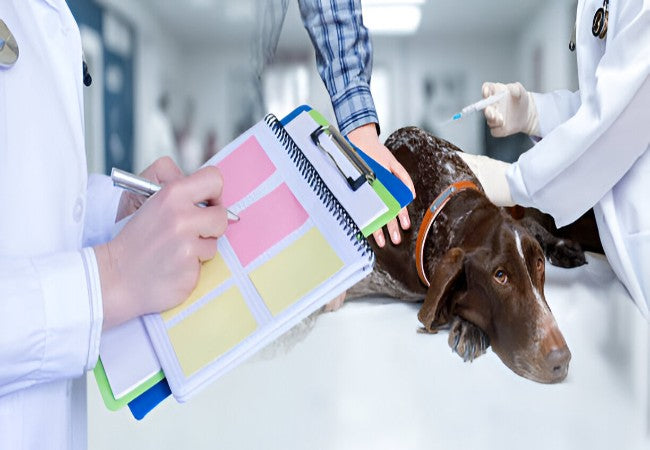Veterinary Guide to Canine Hepatotoxins 2025 🌿🩺

In this article
Veterinary Guide to Canine Hepatotoxins 2025 🌿🩺
By Dr. Duncan Houston BVSc
🧬 What Are Hepatotoxins?
Hepatotoxins are substances—whether drugs, plants, fungi, chemicals, or foods—that can damage the liver by direct toxicity, metabolism into harmful compounds, or cholestatic mechanisms. Hepatotoxicity in dogs may be predictable (dose-related) or idiosyncratic—unpredictable and unrelated to dose.
⚠️ Common Canine Hepatotoxins
- Acetaminophen (paracetamol): causes centrilobular necrosis; antidote is N‑acetylcysteine (NAC).
- NSAIDs: e.g., ibuprofen, carprofen, phenylbutazone—can produce both dose-dependent and idiosyncratic liver injury.
- Lomustine, phenobarbital, and primidone: chemotherapeutics and anticonvulsants linked to chronic hepatitis and cirrhosis risk.
- Xylitol: boosts insulin sharply, can cause hepatic necrosis.
- Alpha‑amanitin mushrooms: potent mushroom hepatotoxins requiring aggressive decontamination.
- Pyrrolizidine alkaloid plants (e.g., ragwort): chronic liver damage.
- Chemicals: aflatoxins, carbon tetrachloride, arsenic—industrial and environmental toxins.
- Herbal supplements: kava, green tea extract, Chinese herbs—known to cause idiosyncratic liver injury.
👥 Which Dogs Are at Risk?
- All dogs are at risk of acute poisoning from toxin ingestion.
- Breed predispositions: Dalmatians, Dobermans, Labs, Shepherds, and Samoyeds show more susceptibility to adverse drug reactions.
- Young dogs—immature metabolic pathways—and older dogs—with chronic disease or polypharmacy—have increased risk.
- Idiosyncratic reactions are unpredictable and not dose-related.
⚠️ Clinical Signs of Hepatotoxicity
Onset may be acute (hours–days) or subacute/chronic weeks later. Signs include:
- GI upset—vomiting, diarrhea, anorexia, abdominal pain.
- Jaundice (icterus) due to impaired bilirubin metabolism.
- Neurologic signs—lethargy, disorientation, hepatic encephalopathy, seizures.
- PUD/diabetes: PU/PD, dehydration, weakness.
- Coagulopathy—bleeding, bruising due to reduced clotting factors.
- Liver failure signs: ascites, abdominal swelling.
🔍 Diagnosing Toxin-Induced Liver Damage
- History & physical: toxin access, dose, timeline, breed risk.
- Bloodwork: ALT/ALP elevated, bilirubin, albumin, clotting times; CBC for anemia or neutrophilia.
- Special drug assays: check acetaminophen, phenobarbital levels when indicated.
- Coagulation profile: PT/PTT if bleeding risk suspected.
- Imaging: ultrasound or CT for cholestasis, masses, MH issues.
- Biopsy or FNA: confirm hepatic necrosis, fibrosis, inflammation when chronic or unclear.
- Toxin-specific tests: acetaminophen metabolites or xylitol blood glucose drop.
🛠️ Emergency Treatment & Management
1. Initial Decontamination
- Induce vomiting if within 1–2 h and safe (no CNS signs, no caustic substances).
- Administer activated charcoal (single or multiple doses as indicated).
- Gastric lavage rarely indicated unless life-threatening toxin is involved.
2. Antidotes and Specific Therapies
- Acetaminophen: start N‑acetylcysteine IV/PO within 12 hours—140 mg/kg loading then 70 mg/kg q6 h.
- NSAIDs: activated charcoal, IV fluids, misoprostol for GI, and NSAID discontinuation.
- Xylitol: dextrose supplementation for hypoglycemia; IV fluids and monitoring hepatic enzymes.
- Mushrooms & plants: supportive decontamination, NAC, antioxidants.
- Chemical hepatotoxins: symptomatic care, NAC, vitamin C for oxidative support.
3. Supportive and Liver-Targeted Care
- IV fluids & electrolytes—correct dehydration and renal perfusion.
- Lactulose, neomycin/metronidazole for hepatic encephalopathy.
- Hepatoprotectants—SAMe, silybin, Vitamin E support regeneration.
- Pain control, antiemetics, GI protectants as needed.
- Coagulopathy management—vitamin K supplementation, plasma transfusion if bleeding present.
- Monitor enzymes, bilirubin, albumin every 24–48h initially.
4. Long-Term Management & Monitoring
- Periodically recheck liver values every 1–3 months until normal.
- Avoid hepatotoxic drugs; review prescription choices with vet.
- Maintain hepatic diet—low-fat, high-quality protein, antioxidant-rich (see Ask A Vet diet plans).
- Long-term supplements: SAMe/silybin daily; vitamin E if indicated.
- Consider liver biopsy if chronic elevation persists without clear cause.
🔬 Prognosis
- Prompt, aggressive treatment of acute toxin ingestion often leads to full recovery.
- Idiosyncratic injury or chronic exposure increases risk of fibrosis or cirrhosis.
- NSAID-related liver disease may be reversible if detected early.
- Severe centrilobular necrosis (e.g., acetaminophen) can result in irreversible liver failure if untreated.
- Long-term quality of life depends on injury severity, residual damage, and compliance.
🛡️ Prevention & Owner Education
- Never give human medications to dogs unless prescribed.
- Store drugs, cleaners, antifreeze, and supplements securely.
- Avoid unsafe mushrooms, toxic plants (e.g., ragwort), contaminated foods, and herbal supplements.
- Vet evaluations before starting long-term medications (e.g., NSAIDs, phenobarbital).
- Annual or biannual bloodwork to screen liver values—especially for high-risk dogs.
📱 Ask A Vet Telehealth Support
- 📸 Instantly share ingestion history, lab results, and photos (mouth, mucous membranes).
- 🔔 Receive real-time emergency guidance: induce vomiting, charcoal dosing, NAC scheduling.
- 🩺 Monitor vitals, appetite, vomiting, and neurologic status via virtual consults.
- 💊 Purrz delivers emergency supplies: activated charcoal, NAC, fluids, SAMe/silybin.
- 🧠 Woopf tracks medication timings, enzyme tracking trends, clinical signs post-toxin.
🎓 Case Spotlight: “Riley” the Labrador
Riley ingested an unknown quantity of ibuprofen from a countertop. He developed vomiting, anorexia, and tremors within 8 hours. Labs showed ALT 500 U/L, ALP 380 U/L, bilirubin 2.5 mg/dL. Treatment: induced vomiting, multi-dose charcoal, IV fluids, protectants (SAMe, silybin), Vitamin K, and discontinued NSAIDs. Riley received daily dose reminders via Ask A Vet, Purrz delivered supplements, and virtual check-ins monitored enzyme trends. Within 3 weeks, labs normalized and Riley returned to active health 🐾.
🔚 Key Takeaways
- Hepatotoxins include drugs, toxins, mushrooms, plants, and supplements that can injure the liver.
- Clinical signs range from GI upset and lethargy to jaundice, encephalopathy, bleeding, and liver failure.
- History, labs, imaging, and sometimes biopsy are crucial for diagnosis.
- Immediate decontamination, antidotes, supportive care, and liver support are key to treatment.
- Prognosis depends on promptness of care, toxin type, injury severity, and dog’s health.
- Prevention involves safe storage, avoiding toxic items, and routine vet screenings.
- Ask A Vet telehealth helps with emergency advice, treatment coordination, supplement delivery, and long-term monitoring 📲🐕
Dr Duncan Houston BVSc, founder of Ask A Vet. Download the Ask A Vet app for immediate telehealth—helping with toxin ingestion emergencies, liver support planning, decontamination protocols, medication delivery, and monitoring to ensure your dog recovers safely 🐶📲






